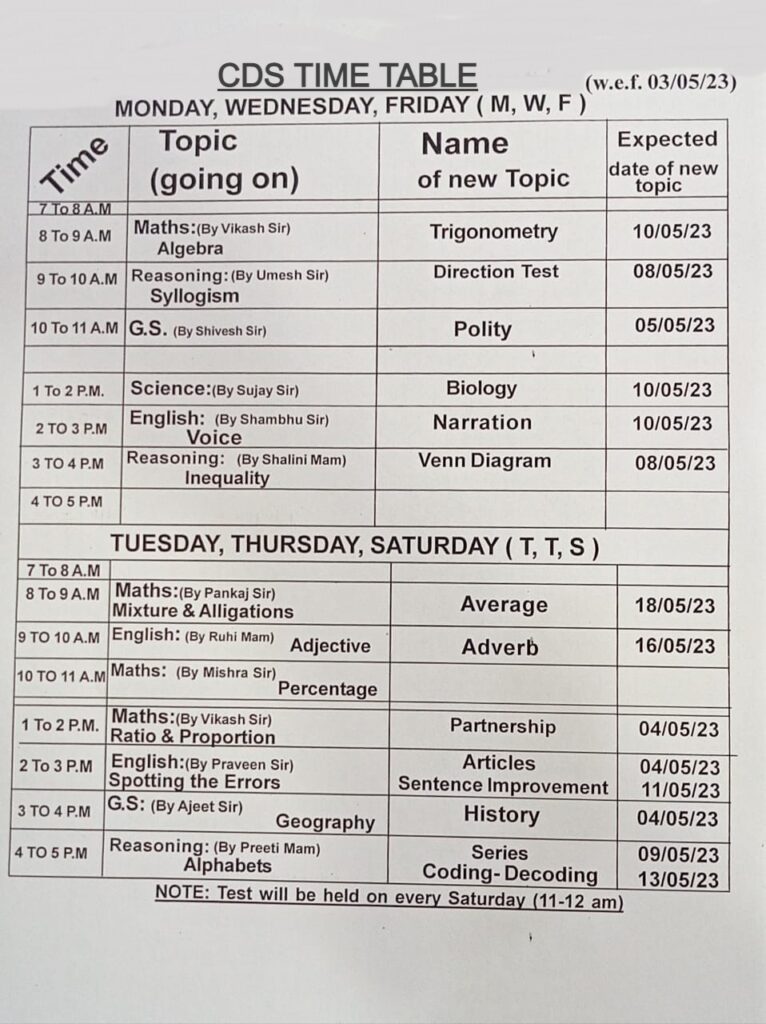CDS is conducted by the UPSC twice a year. University graduates or those in final year of graduation are eligible to appear in the examination. Candidates qualifying in written examination have to undergo SSB interview and medical tests. Candidates whose names appear in the merit list undergo basic military training of 18 months at Indian Military Academy/ Air Force Academy/ Naval Academy for Permanent Commission and 11 months at Officers Training Academy (OTA) to become Short Service Commissioned Officers (SSCOs). SSCOs can serve for a duration of 10 years extendable to 14 years. However, they can opt for permanent commission after completion of 10 years or seek release after completion of five years of service, which is considered on case to case basis .


Subjects
Subjects
IMA / INA / AFA
Maths – 100 Questions (2 hours )
GAT – (English + GA) 240 Questions (4 hours )
Both Male & Female are eligible (Till 18-24 yrs)
OTA
English – 120 Questions (2 hours )
G.A – 120 Questions ( 2 hours )
MODE OFFLINE
Phase I
Written
Phase II
SSB (5 days)
Phase III
Merit List + Joining
NOTE: NCC -C- Certificate holder can directly enter SSB .(without appearing in written exam )
Both Male & Female are eligible till the age of 20-24 yrs.
CDS Syllabus consists mainly of English, General Knowledge, and Elementary Mathematics for the admission to Indian Naval Academy, Indian Military Academy and Air Force Academy while for admission to the Officers’ Training Academy, only English and General Knowledge subjects are included. For detailed topic-wise coverage, refer to the following article.
CDS Syllabus for Mathematics
| Arithmetic | Number SystemNatural numbers, Integers, Rational and Real numbers.Fundamental operations, addition, subtraction, multiplication, division, Square roots, Decimal fractions.Unitary method, time and work, time and distance, percentages.Applications of profit and loss, simple and compound interest, ratio and proportion, variation.Elementary Number TheoryDivision algorithm.Prime and composite numbers.Tests of divisibility by 2, 3, 4, 5, 9 and 11.Multiples and factors.Factorisation Theorem.H.C.F. and L.C.M.Euclidean algorithm.Logarithms to base 10, use of logarithmic tables, laws of logarithms. |
| Algebra | Basic operations and Simple factors,Remainder Theorem.H.C.F. and L.C.M.Theory of polynomials, relation between its roots and coefficients (Only real roots to be considered), solutions of quadratic equations.Simultaneous linear equations in two unknowns — analytical & graphical solutions.Simultaneous linear inequations in two variables & their solutions.Practical issues with solutions that result in two simultaneous linear equations, inequalities in two variables, or quadratic equations in one variable.Set notion and set language.Rational expressions and conditional identities.Laws of indices. |
| Trigonometry | Sine x, cosine x, Tan x when 0° < x < 90° , Values of sin x, cos x & tan x, for x = 0°, 30°, 45°, 60° & 90°.Simple trigonometric identities.Use of trigonometric tables.Simple cases of heights and distances. |
| Geometry | Plane and plane figures, Lines and angles, Theorems on:Properties of angles at a pointParallel linesSides and angles of a triangleCongruency of trianglesSimilar trianglesConcurrence of medians and altitudesProperties of sides, angles and diagonals of a rectangle, parallelogram and squareCircles and their properties including tangents and normalsLoci |
| Mensuration | Areas of parallelograms, squares, rectangles, triangles and circles.Areas of figures can be split up into these figures (Field Book), lateral surface and volume of right circular cones and cylinders, Surface area and volume of cuboids, and surface area and volume of spheres. |
| Statistics | Collection and tabulation of statistical data.Graphical representation of frequency polygons, bar charts, histograms, pie charts etc.Measures of central tendency. |
